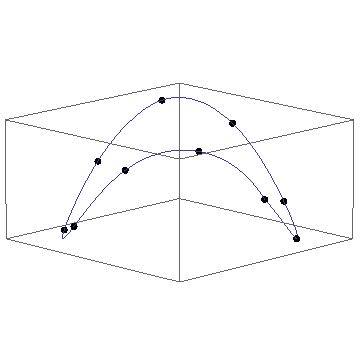Higher order periodic interpolation (curve fitting)
It does seem that the options PeriodicInterpolation -> True and Method -> "Spline" are incompatible, so I'll give a method for implementing a genuine cubic periodic spline for curves. First, let's talk about parametrizing the curve.
Eugene Lee, in this paper, introduced what is known as centripetal parametrization that can be used when one wants to interpolate across an arbitrary curve in $\mathbb R^n$. Here's a Mathematica implementation of his method:
parametrizeCurve[pts_List, a : (_?NumericQ) : 1/2] /; MatrixQ[pts, NumericQ] :=
FoldList[Plus, 0, Normalize[(Norm /@ Differences[pts])^a, Total]]
The default setting of the second parameter for parametrizeCurve[] gives the centripetal parametrization. Other popular settings include a == 0 (uniform parametrization) and a == 1 (chord length parametrization).
Now we turn to generating the derivatives needed for periodic cubic spline interpolation. This is done through the solution of an appropriate cyclic tridiagonal system, for which the functions LinearSolve[], SparseArray[], and Band[] come in handy:
periodicSplineSlopes[pts_?MatrixQ] :=
Module[{n = Length[pts], dy, ha, xa, ya}, {xa, ya} = Transpose[pts];
ha = {##, #1} & @@ Differences[xa];
dy = ({##, #1} & @@ Differences[ya])/ha;
dy = LinearSolve[SparseArray[{Band[{2, 1}] -> Drop[ha, 2],
Band[{1, 1}] -> ListConvolve[{2, 2}, ha],
Band[{1, 2}] -> Drop[ha, -2],
{1, n - 1} -> ha[[2]], {n - 1, 1} -> ha[[-2]]}],
3 MapThread[Dot[#1, Reverse[#2]] &,
Partition[#, 2, 1] & /@ {ha, dy}]];
Prepend[dy, Last[dy]]]
Using Sjoerd's example:
sc = Table[{Sin[t], Cos[t], Cos[t] Sin[t]}, {t, 0, 2 π, π/5}] // N;
tvals = parametrizeCurve[sc]
{0, 0.102805, 0.196242, 0.303758, 0.397195, 0.5, 0.602805, 0.696242,
0.803758, 0.897195, 1.}
cmps = Transpose[sc];
slopes = periodicSplineSlopes[Transpose[{tvals, #}]] & /@ cmps;
{f1, f2, f3} = MapThread[Interpolation[Transpose[{List /@ tvals, #1, #2}],
InterpolationOrder -> 3, Method -> "Hermite",
PeriodicInterpolation -> True] &,
{cmps, slopes}];
Plot the space curve:
Show[ParametricPlot3D[{f1[u], f2[u], f3[u]}, {u, 0, 1}],
Graphics3D[{AbsolutePointSize[6], Point[sc]}]]

Individually plotting the components and their respective derivatives verify that the interpolating functions are $C^2$, as expected of a cubic spline:

You are talking about a list of 3D points and curve fitting. I therefore assume you want a function with a single parameter that describes a curve fitting through your set of points. I don't believe ListInterpolate can handle that.
My alternative is the following.
First, a set of 3D points:
pts1 = Table[{Sin[t], Cos[t], Cos[t] Sin[t]}, {t, 0, 2 \[Pi], \[Pi]/5}] // N;
I get incomprehensible errors (Interpolation::mspl: The Spline method could not be used because the data could not be coerced to machine real numbers) if I interpolate using the "Spline" method combined with PeriodicInterpolation. I therefore add the 2nd and 3rd point to the end of the array (the last and first one were already the same). This ensures a smooth connection of beginning and end of the list:
pts2 = Join[pts1, pts1[[2 ;; 3]]];
I now interpolate through each dimension separately:
f = Interpolation[#, InterpolationOrder->3, Method->"Spline"] & /@Transpose[pts2]
Plot the result:
p = Show[
ParametricPlot3D[Through[f[x]], {x, 1, Length[pts1]}, Axes -> None],
Graphics3D[{PointSize[0.02], Point@pts1}]
]
